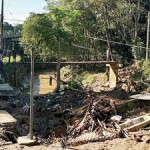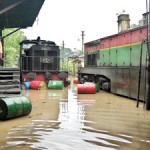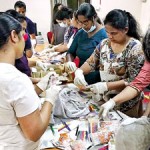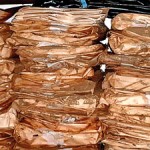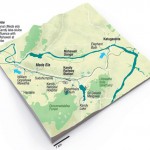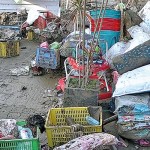News
Kandy floods expose the corruption behind unauthorised structures
View(s):By Nadia Fazlulhaq and J.A.L. Jayasinghe
The reasons are many. They include clogged drains, blocked natural waterways, unauthorised constructions, illegal encroachments, uncoordinated development programmes, delayed projects, and neglected silt traps. But the Central Province Governor and others point to unchecked corruption, especially among politicians and officials.
The Christmas day rains were unusually heavy with Kandy receiving the highest rainfall. Video clips that went viral on social media showed a strong and sudden gush of muddy water flowing into the Kandy railway station from the Bogambara side. Vehicles were swept into the Meda Ela. The floods caused damage to files and computers at the Central Province Education Department and the Advanced Technological Institute.
- After the floods: Scenes from Akurana
- Flooded out: Kandy’s railway station. Pix by Chandana Uduwawala,Teldeniya
- Central Province Education Dept: Files drenched in muddy waters (top) and volunteers salvage stationery items for schoolchildren donated by UNICEF
The Province’s Education Director Amarasiri Piyadasa, said he was distraught to find files on lower shelves drenched in muddy waters. Personal files and files on loan applications and disciplinary action, ledgers, textbooks, Advanced Level papers, stationery, and books donated by UNICEF were damaged by the flood water that reached three feet.
He said employees and volunteers tried their best to salvage the files. Some of those who cleared the muddy residue that had a stench fell sick. “We have taken the files to our Gurudeniya centre where we are doing our best to restore them,” he said.
He said felt pens and pastel sets were among the items donated by UNICEF to be distributed among schoolchildren from low-income families. He said soaked books and craft paper were being dried and disinfected before they were distributed among the children.
At the Advanced Technological Institute, among the items that have been damaged by the floods are printers and computers.
The Kandy railway station saw water flowing into the parcel section and the ticket counter.
“Aerial maps of Kandy’s land and streams show a vast difference between the 1970s and now. Now these areas have been thickly populated and polluted while the wide streams that once added beauty to the city are now mere narrow canals,” said Peradeniya University’s geology Professor Athula Senerath.
He said local politicians gave permits for structures to be built on the Mahaweli reservation and they later became permanent buildings. “There is no 60-metre distance between the river and the land. The canals in Kandy city and Akurana have structures stretched up to the edge,” he said.
The city witnessed booming development with court, hospital, and shopping complexes being built amid businesses sprouting, but many ignored the importance of a proper water drainage system, the professor said.
City development expert Eng. A.G.S.A. Nanayakkara said one of the reasons for the floods was the Kandy Municipal Council’s failure to maintain and clear Kandy Lake’s silt traps.
He accused shops and traders of disposing of garbage in the drain system.
Eng. Nanayakkara, who worked as a consultant for Kandy’s Strategic Cities Development Project under the former Ministry of Megapolis, said building a bypass canal could be a solution but it would be costly as it involved relocating people and businesses even though most of them were encroachers.
According to him, lack of storm-water retention ponds for the water flowing from the Dunumadalawa reservoir during heavy rains is also a reason for flooding.
Even near the new Goods Shed Terminal bus stand, the land had been encroached and drainage paths are blocked, he said.
The Provincial Engineering Services Director W.M.A. Wickremasinghe acknowledged that with development work, the drainage system had gradually become narrower and that this was one of the reasons for floods.
Kandy Mayor Kesara Senanayake blamed unauthorised buildings that obstruct the drain system between Suduhumpola and Deiyyanwela for the floods whileCentral Province Governor Lalith U. Gamage said a special meeting had been convened on January 9 to find a solution to the crisis.
He said a technical committee comprising the Provincial Engineer, the Municipal Commissioner and officials from the Urban Development Authority, the Road Development Authority and the Water Board. (Please see the box story.)
He said he was aware that waste water from Hantane was being released to a narrow drain. Pointing to a new waste water project being carried out by the Water Board, the governor said work had been going on for more than a decade and as a result of the delay, flood mitigations plans were at a standstill.
He also accused local council representatives and officials of permitting illegal constructions and buildings along the streams and Mahaweli reservation lands.
Asked why illegal constructions could not be removed as soon as they were brought to the notice of the authorities, the governor said most structures become permanent during the time taken to get a demolition order.
“It is better to prevent than to demolish. Political influence has played a major role in giving lands and permission to put up structures. The authorities should be able to get a prevention order before any construction has taken place,” he said.
“Near the Kandy hospital, over four acres have been claimed by squatters. The KMC has powers to remove any construction that blocks drainages and waterways,” he said.
| Governor appoints panel to find solution By L.B. Senaratne In the aftermath of devastating floods in Akurana and Kandy town during the recent rains, Central Province Governor Lalith U. Gamage has appointed a committee to study the issue and come up with short-term, mid-term and long-term solutions. The Committee met on Wednesday with Deputy Mayor Ilahi Abdeen presiding, but journalists were not allowed to cover the meeting. He said the committee members cited the felling of trees, unauthorised construction and the municipality not taking prompt action on environmental issues as some of the main causes of the floods. When asked why the media were not allowed to cover the meeting, he said that as a rule when crucial decisions were to be taken, the media were kept out. The meeting was mainly about protecting Kandy, a historic and world heritage city, he said. | |
The best way to say that you found the home of your dreams is by finding it on Hitad.lk. We have listings for apartments for sale or rent in Sri Lanka, no matter what locale you're looking for! Whether you live in Colombo, Galle, Kandy, Matara, Jaffna and more - we've got them all!


